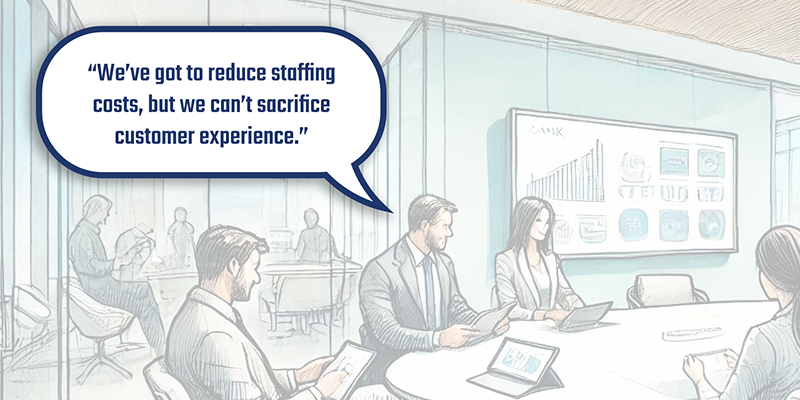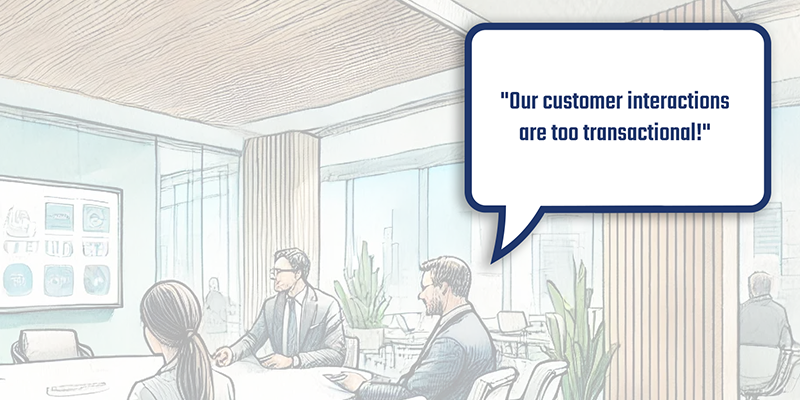The Modern Teller Cash Recyclers You Need
Improve branch efficiency and deepen customer relationships with the future of TCR technology.
Does This Sound Familiar?




Your Vision for the Future of Branch Operations
You're ready to move beyond the old, segmented branch layouts and into a future where every space is optimized and your team is cross-trained to handle any need. With Teller Cash Recyclers (TCRs), you get a modern, secure, and efficient environment—a branch that feels welcoming and works seamlessly. This is about creating a space where your staff can truly engage with customers, driving efficiency and making every interaction count.
“With transaction counts declining, and customers coming into the branch, we wanted to use that time more wisely.”
Jennifer George
COO Community Bank PA
“It makes the transaction more personable when your client is standing across from you. It also makes it more secure.”
Kristen Zbozien
Retail Team Lead TriStar Bank
From Transactions to Interactions
Teller Cash Recyclers (TCRs) are changing the game for financial institutions by automating cash-handling tasks that used to consume your staff’s time. This allows your team to shift from just processing transactions to engaging in meaningful interactions with customers. With TCRs, you’re not just improving efficiency—you’re creating a branch environment where your staff can focus on what truly matters: delivering the best expertice while developing deeper relationships and in-balance transactions.
We're Your Branch Optimization Partner
You can count on QDS for unmatched expertise, collaboration, and support to make your TCR transition smooth and effective.
Technology + Expertise
With unmatched expertise in TCR technology, we deliver solutions that directly improve your branch operations. As the top Hyosung TCR provider, we focus on driving efficiency and customer satisfaction.
Collaborative Approach
We're ready to collaborate with your design partners to seamlessly integrate our TCR solutions into your branch, ensuring they complement your operational goals without the need for redesign.
Strong Partnerships
Our strong partnership with Hyosung, combined with project management investment, ensures top-tier implementation and support as the largest Hyosung TCR provider in the country.
Support + Training
Our training, led by former tellers, ensures your staff are comfortable with the new technology. We'll help you prevent costly underutilization and empower your team to fully embrace the change.
The Hyosung MS500 Edge
Learn what sets the Hyosung MS500 apart in making your branch operations smoother and more efficient.
.png)
Cassette-Based Technology
Unlike roll storage, the Hyosung MS500’s cassette system keeps cash flat and secure, preventing curling. This means faster processing, larger capacity, and a smoother experience for your customers.
.png)
Transit Cassette Functionality
The Hyosung MS500’s transit cassette allows secure cash transfers and quick self-audits, cutting audit time from 90 minutes to just 20. This enables you to make cash handling safer and more efficient.
.png)
Overflow
Cassette
Busy branches like yours must be efficient. The Hyosung MS500’s overflow cassette automatically manages excess cash, ensuring transactions continue smoothly without interruptions.
Middleware vs. Direct Integration
The way you integrate your Teller Cash Recyclers can have a big impact on your branch’s day-to-day efficiency. Middleware gives you more control, saves costs, and keeps things flexible. It works well with different teller systems and easily adapts if you decide to change core providers, making it a smart, future-proof option for most branches.
-
What is the difference between middleware and direct integration?
Middleware serves as an intermediary layer between your teller system and the Teller Cash Recycler (TCR), allowing for full utilization of advanced features like transit cassettes and self-audit functionality. Direct integration, on the other hand, connects the TCR directly to the teller system, often with more limited functionality focused on basic transactions.
-
Why are the advantages of middleware over direct integration?
Middleware offers more robust control and full access to TCR features, simplifying issue resolution and providing a seamless support experience. It’s also cost-effective for smaller institutions and more flexible when switching teller platforms.
-
What are the disadvantages of middleware?
Middleware may require an additional balancing step at the end of the day, and there could be higher initial costs for larger fleets. However, these costs are typically offset by the comprehensive control and functionality middleware provides.
-
What are the advantages of direct integration?
Direct integration allows for immediate communication between the teller system and TCR hardware. Some systems may support real-time updates, which can be helpful in specific scenarios.
-
What are the challenges with direct integration?
Direct integration is usually limited to basic transactions, which means you may not have access to advanced TCR features. It can also be less flexible when switching systems, leading to potentially higher costs and operational disruptions. Additionally, if issues arise, there’s a risk of finger-pointing between vendors, complicating support and maintenance.
-
Which approach is more cost-effective for my institution?
For smaller institutions, middleware can be more cost-effective due to its flexibility and lower ongoing maintenance needs. However, larger fleets might face higher initial costs with middleware, though these costs are often justified by the additional functionality and control it offers.
-
What does QDS recommend for most institutions?
QDS generally recommends middleware for its greater control, functionality, and support, making it the better long-term solution for many institutions.
-
How does middleware handle cash reconciliation and balancing?
Middleware often requires an additional balancing step at the end of the day, where data from the TCR is reconciled with the teller system. This ensures accurate cash tracking and proper functionality of advanced features like transit cassettes.
-
Can middleware work across multiple teller systems and TCR models?
Yes, middleware is generally more flexible, allowing institutions to switch between different teller platforms or TCR models without needing to overhaul the entire integration setup. This is particularly useful for institutions planning to scale or update their systems over time.
-
What are the security implications of using middleware vs. direct integration?
Middleware can offer enhanced security by managing the cash environment more comprehensively. It supports features like self-audit functionality and controls access to cash more strictly. Direct integration, being simpler, might expose fewer attack surfaces, but also provides less control over security features like audit trails.
-
What are the maintenance and support considerations for middleware compared to direct integration?
Middleware simplifies support by keeping the entire environment under QDS’ control, which can reduce the complexity of issue resolution. In direct integration setups, there’s often more coordination required between vendors, which can lead to slower resolution times if an issue spans multiple systems.
-
Can middleware integrate with third-party tools or software?
Middleware often offers APIs or other integration points that allow it to work with third-party tools, including CRM systems, cash management software, and reporting tools, providing more comprehensive data insights and control over operations.
-
How does middleware handle system failures or downtime?
Middleware can offer redundancy and failover options, ensuring that operations continue smoothly even if parts of the system experience downtime. It also centralizes error handling, making it easier to diagnose and resolve issues quickly compared to direct integration, which might require coordination between multiple vendors.

“At QDS, our focus is on providing solutions that not only improve branch efficiency but also deepen customer relationships. With our advanced TCR technology, you're not just optimizing staff operations, you're transforming the entire branch experience. Our clients find that TCRs quickly become an indispensable part of their team, automating the transactional tasks so your staff can focus on what really matters – engaging with customers and driving results.”
— Sean Farrell, CEO of Quality Data Systems
QDS Client Success Stories
Hear directly from our clients about what it's like to work with QDS.
Tristar Bank Achieved
-
More secure transactions
-
Improved customer interactions
-
Efficiency gain for staffing
First Bank Achieved
-
More efficient transactions
-
Smoother cash handling
-
Increased capacity and speed
Carter Bank Achieved
-
Optimized branch efficiencies
-
Improved staffing utilization
-
A strategic partner with QDS
